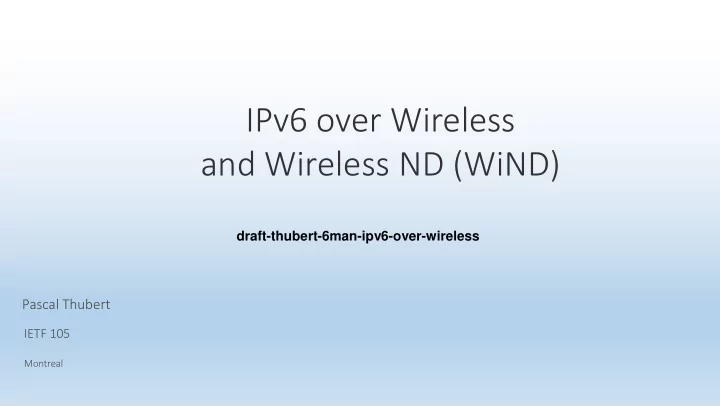

IPv6 over Wireless and Wireless ND (WiND) draft-thubert-6man-ipv6-over-wireless Pascal Thubert IETF 105 Montreal 1
Unmet expectations C A • IPv6 ND is designed for P2P and Transit Links B • Wireless is natively non-transitive • Requires extensions for NBMA or L2 transit emulation • IPv6 ND over L2 transit emulation is not wireless friendly Non transitive: • E.g., over L2R, learning bridges, Wi-Fi Infrastructure Mode B can talk to A and C but A and C cannot • Broadcast intensive (no support for multicast) see reach other • Other mismatches • Fast Roaming ‘11r’ (ND has no sense of order of events) • Intermittent Connectivity (fails all of NUD, DAD and lookup) • Fast Initial Link Setup ‘11ai’ (ND is reactive, causes loss of first packets) • Increased sensitivity to DoS attacks (Use ND to trigger broadcasts remotely)
Link and Link Local vs. PHY broadcast domain Hub_B • A plain radio Interface connects to a B::B/64 Spoke_C physical radio broadcast domain Spoke_A B::C/64 (vs. a MAC-layer emulated broadcast domain) B::A/64 • An IPv6 bidirectional Link can be created where radio broadcast domain overlap enough that A sees B and B sees A. • Link-Local Addresses need to be unique for a communicating pairs only • The IPv6 Link is usually reflexive though often asymmetrical • The IPv6 Link is usually not transitive unless special measures taken • As a node moves, it meets other nodes and IPv6 Links are formed
A belongs to 2 subnets at a Other Things to Adjust time A C b::a/64 B c::c/64 • Matching source IP to router c::a/64 b::b/64 • A must with radio mobility • E.g., car A attached to RSUs B & C • Each RSU enforcing SAVI for its prefix • Providing reachability back to a CoA based on its prefix • Aggressive DNA (Detecting Network attachment) • Rapid discovery (advertisement interval option in RA) • Permanently assess reachability of DRL and prune rapidly • May reuse a GUA if come back within reg. lifetime
Backup 5
Questions to the group • Archiving value -> should we publish ? • Transfer WiND to 6MAN for maintenance and extensions? • Generalize RFC 8505 (and WiND suite) over non-6lo Link ?
Status • Triggered by IPWAVE IPv6-over-OCB, need a baseline for wireless • Inherit from 10 years of work at 6lo, millions of nodes deployed • draft-thubert-6man-ipv6-over-wireless-03 out • Discusses radio broadcast domain, native and emulated • Introduces WiND, compares to ND on native MAC (no emulation) • Discusses applicability / use cases • Next rev on host and routers behavior, e.g., matching router.
RFC 8505 registration vs. 802.11 association ▪ Association allows a proactive setting of the bridging state ▪ Allows the APs to eliminate broadcast lookups ▪ Compares to reactive learning bridge ▪ WiND ▪ Reproduces the association model at L3 ▪ Leverages the state for address protection and SAVI ▪ Routing inside the subnet replaces bridging ▪ Proxy ND at the wire / wireless edge
P2P, the simplest SubNet models subnet model A B Hub_B B::B/64 Node_C Spoke_A Node_B Spoke_C MESH::C/64 B::A/64 MESH::B/64 B::C/64 Node_D Node_A Node_E MESH::D/64 MESH::A/64 MESH::E/64 Hub and Spoke HUB_B maintains state for visitors for their registration Route-Over Mesh, lifetime and relays packet requires a routing protocol
WiND General Design 6LN(STA) 6BBR(L3-AP) 6LBR default GW | | | | | Wireless Access | IPv6 Backbone (e.g., Ethernet) | | | | | | RS(multicast) | | | |---------------->| | | • Registration for guaranteed service | RA(PIO, Unicast)| | | |<----------------| | | • Even with intermittent connectivity | NS(EARO) | | | |---------------->| | | | | Extended DAR | | • DAD protection on behalf for lifetime | |--------------->| | | | Extended DAC | | • Extensible for lookup | |<---------------| | | | | | | NS-DAD(EARO, multicast) | • Routing vs. Bridging Proxy | |--------> | | |---------------------------------->| | | | • Bridging advertises the SLLA of the 6LN | | RS(no SLLAO, for ODAD) | | |---------------------------------->| | | (if no fresher Binding) NS(Lookup)| • Routing hides the 6LN and routes | | <---------------| | |<----------------------------------| • Routing keeps L2 stable | | NA(SLLAO, not(O), EARO) | | |---------------------------------->| | | RA(unicast) | • Model | |<----------------------------------| | | | | IPv6 Packets in optimistic mode | • Link is broadcast domain |<--------------------------------------------------->| | | | • Subnet <> Link | | | NA(EARO) |<DAD timeout> |<----------------| => Not on-link and routing | |
6lo standard work A proactive setting of proxy/routing state to avoid multicast due to reactive Duplicate address detection and lookup in IPv6 ND • RFC 8505 (Issued 11/2018) • The registration mechanism for proxy and routing services • Analogous to a Wi-Fi association but at Layer 3 • draft-ietf-6lo-backbone-router (WGLC complete 1/25) • Federates 6lo meshes over a high-speed backbone • ND proxy analogous to Wi-Fi bridging but at Layer 3 • draft-ietf-6lo-ap-nd (WGLC complete 3/26) • Protects addresses against theft (Crypto ID in registration) • draft-thubert-6lo-unicast-lookup • Provides a 6LBR on the backbone to speed up DAD and lookup • draft-thubert-6man-ipv6-over-wireless (new draft) NEW DRAFT • IPv6 ND vs. WiND applicability to wireless networks
Recommend
More recommend